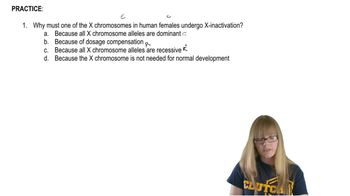Earlier, we described CC, the cat created by nuclear transfer cloning, whereby a diploid nucleus from one cell is injected into an enucleated egg cell to create an embryo. Cattle, sheep, rats, dogs, and several other species have been cloned using nuclei from somatic cells. Embryos and adults produced by this approach often show a number of different mitochondrial defects. Explain possible reasons for the prevalence of mitochondrial defects in embryos created by nuclear transfer cloning.
Table of contents
- 1. Introduction to Genetics51m
- 2. Mendel's Laws of Inheritance3h 37m
- 3. Extensions to Mendelian Inheritance2h 41m
- 4. Genetic Mapping and Linkage2h 28m
- 5. Genetics of Bacteria and Viruses1h 21m
- 6. Chromosomal Variation1h 48m
- 7. DNA and Chromosome Structure56m
- 8. DNA Replication1h 10m
- 9. Mitosis and Meiosis1h 34m
- 10. Transcription1h 0m
- 11. Translation58m
- 12. Gene Regulation in Prokaryotes1h 19m
- 13. Gene Regulation in Eukaryotes44m
- 14. Genetic Control of Development44m
- 15. Genomes and Genomics1h 50m
- 16. Transposable Elements47m
- 17. Mutation, Repair, and Recombination1h 6m
- 18. Molecular Genetic Tools19m
- 19. Cancer Genetics29m
- 20. Quantitative Genetics1h 26m
- 21. Population Genetics50m
- 22. Evolutionary Genetics29m
2. Mendel's Laws of Inheritance
Sex-Linked Genes
Problem 18
Textbook Question
The gene causing Coffin–Lowry syndrome (OMIM 303600) was recently identified and mapped on the human X chromosome. Coffin–Lowry syndrome is a rare disorder affecting brain morphology and development. It also produces skeletal and growth abnormalities, as well as abnormalities of motor control. Coffin–Lowry syndrome affects males who inherit a mutation of the X-linked gene. Most carrier females show no symptoms of the disease but a few carriers do. These carrier females are always less severely affected than males. Offer an explanation for this finding.
 Verified step by step guidance
Verified step by step guidance1
Understand that Coffin–Lowry syndrome is an X-linked disorder, meaning the gene responsible for the condition is located on the X chromosome. Males (XY) have only one X chromosome, while females (XX) have two.
Recognize that males who inherit the mutated gene on their single X chromosome will express the disorder because they lack a second X chromosome to compensate for the mutation.
For females, who have two X chromosomes, one of the X chromosomes in each cell is randomly inactivated during early embryonic development. This process is called X-inactivation or lyonization, and it ensures that only one X chromosome is active in each cell.
In carrier females, some cells will have the X chromosome with the normal gene active, while others will have the X chromosome with the mutated gene active. This mosaic pattern of X-inactivation typically results in less severe symptoms compared to males, as the normal gene can partially compensate for the mutated one.
The variability in symptom severity among carrier females can be explained by the randomness of X-inactivation. If a higher proportion of cells inactivate the X chromosome with the normal gene, the symptoms may be more pronounced. Conversely, if more cells inactivate the X chromosome with the mutated gene, the symptoms will be milder or absent.
 Verified video answer for a similar problem:
Verified video answer for a similar problem:This video solution was recommended by our tutors as helpful for the problem above
Video duration:
2mPlay a video:
Was this helpful?
Key Concepts
Here are the essential concepts you must grasp in order to answer the question correctly.
X-Linked Inheritance
X-linked inheritance refers to the pattern of genetic transmission of genes located on the X chromosome. Males have one X and one Y chromosome, so a single mutated gene on the X chromosome will manifest as a disorder. In contrast, females have two X chromosomes, meaning they can be carriers of a mutation without showing symptoms, as the normal allele on the other X can compensate.
Recommended video:
Guided course

X-Inactivation
Dosage Compensation
Dosage compensation is a genetic mechanism that balances the expression of X-linked genes between males and females. In mammals, one of the two X chromosomes in females is randomly inactivated (X-inactivation), leading to a situation where females express only one functional copy of X-linked genes. This results in carrier females often exhibiting milder symptoms compared to affected males, who express the mutation from their single X chromosome.
Recommended video:
Guided course

Purpose of X Inactivation
Variable Expressivity
Variable expressivity refers to the phenomenon where individuals with the same genetic mutation exhibit different degrees of severity in symptoms. In the case of Coffin–Lowry syndrome, while most carrier females are asymptomatic or mildly affected, some may show symptoms due to factors such as the specific mutation, environmental influences, or the random nature of X-inactivation, leading to a range of phenotypic outcomes.
Recommended video:
Guided course

Penetrance and Expressivity
Related Videos
Related Practice
Textbook Question
402
views


